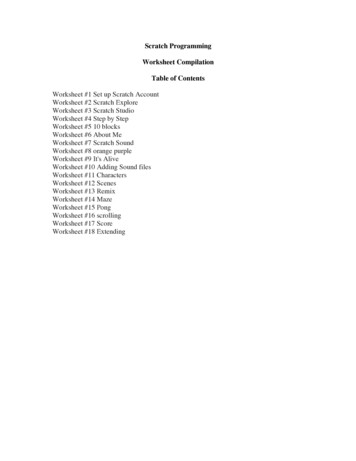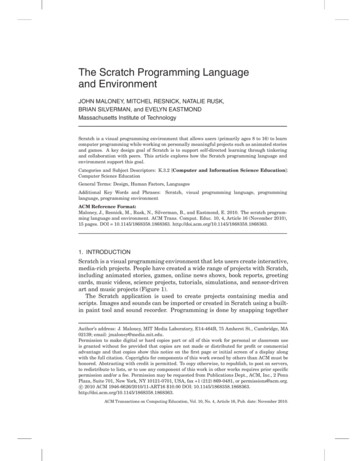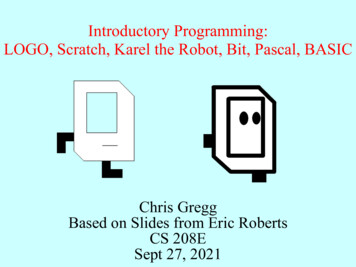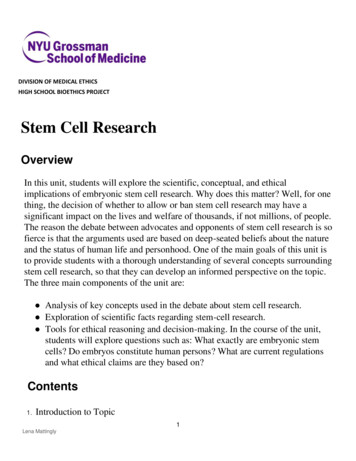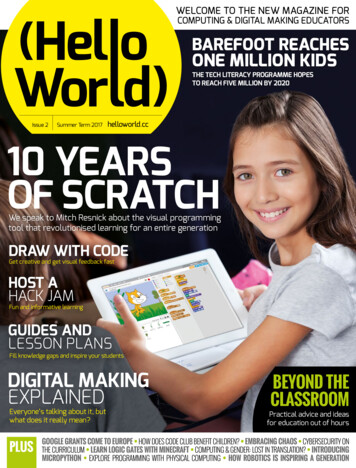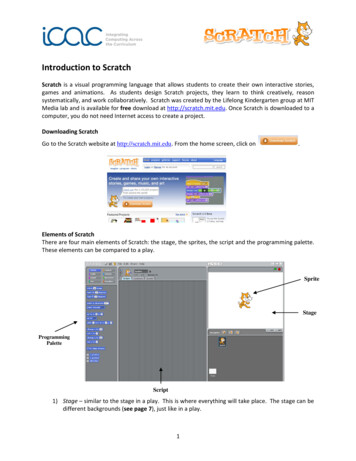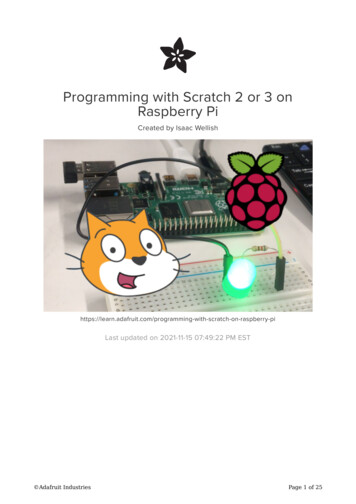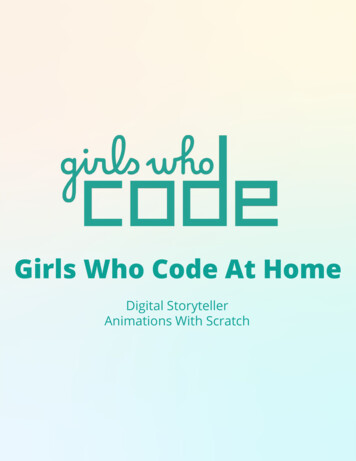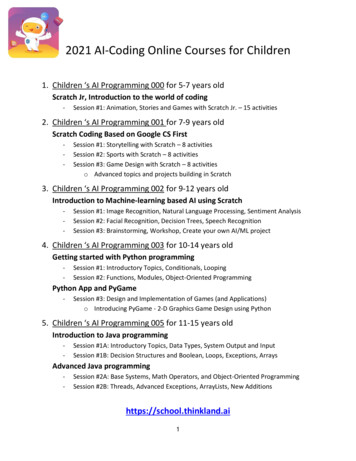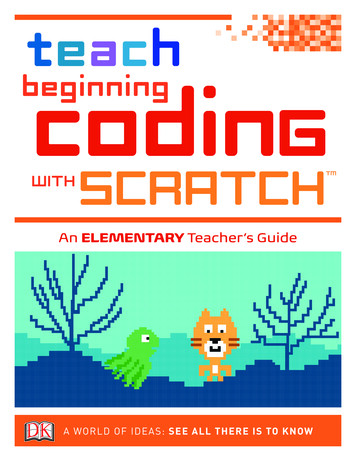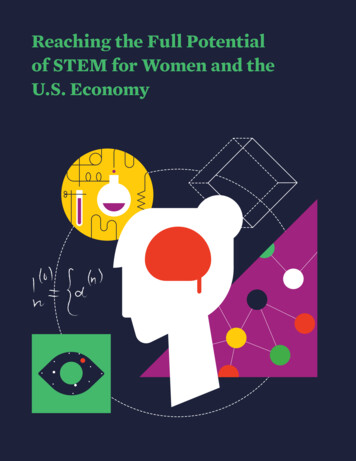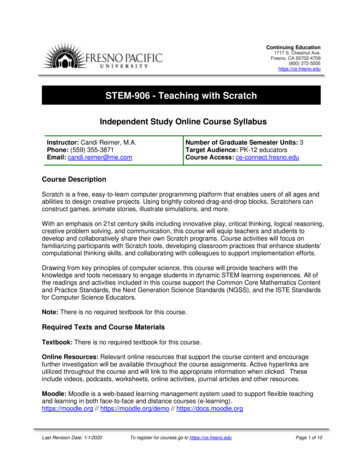
Transcription
Continuing Education1717 S. Chestnut Ave.Fresno, CA 93702-4709(800) 372-5505https://ce.fresno.eduSTEM-906 - Teaching with ScratchIndependent Study Online Course SyllabusInstructor: Candi Reimer, M.A.Phone: (559) 355-3871Email: candi.reimer@me.comNumber of Graduate Semester Units: 3Target Audience: PK-12 educatorsCourse Access: ce-connect.fresno.eduCourse DescriptionScratch is a free, easy-to-learn computer programming platform that enables users of all ages andabilities to design creative projects. Using brightly colored drag-and-drop blocks, Scratchers canconstruct games, animate stories, illustrate simulations, and more.With an emphasis on 21st century skills including innovative play, critical thinking, logical reasoning,creative problem solving, and communication, this course will equip teachers and students todevelop and collaboratively share their own Scratch programs. Course activities will focus onfamiliarizing participants with Scratch tools, developing classroom practices that enhance students’computational thinking skills, and collaborating with colleagues to support implementation efforts.Drawing from key principles of computer science, this course will provide teachers with theknowledge and tools necessary to engage students in dynamic STEM learning experiences. All ofthe readings and activities included in this course support the Common Core Mathematics Contentand Practice Standards, the Next Generation Science Standards (NGSS), and the ISTE Standardsfor Computer Science Educators.Note: There is no required textbook for this course.Required Texts and Course MaterialsTextbook: There is no required textbook for this course.Online Resources: Relevant online resources that support the course content and encouragefurther investigation will be available throughout the course assignments. Active hyperlinks areutilized throughout the course and will link to the appropriate information when clicked. Theseinclude videos, podcasts, worksheets, online activities, journal articles and other resources.Moodle: Moodle is a web-based learning management system used to support flexible teachingand learning in both face-to-face and distance courses (e-learning).https://moodle.org // https://moodle.org/demo // https://docs.moodle.orgLast Revision Date: 1/1/2020To register for courses go to https://ce.fresno.eduPage 1 of 10
Course DatesSelf-paced; students may enroll at any time and take up to one year, from the date of registration, tocomplete assignments. Students may complete assignments in no less than three weeks for a 3unit course (one week per unit).National Standards Addressed in This CourseCommon Core Standards for Mathematics ics Counting & Cardinality Operations & Algebraic Thinking Number & Operations Measurement & Data Geometry Ratios & Proportional Relationships The Number System Expressions & Equations Functions Statistics & ProbabilityCommon Core Standards for Mathematical / Standard 1: Make sense of problems and persevere in solving them Standard 2: Reason abstractly and quantitatively Standard 3: Construct viable arguments and critique the reasoning of others Standard 4: Model with mathematics Standard 5: Use appropriate tools strategically Standard 6: Attend to precision Standard 7: Look for and make use of structure Standard 8: Look for and express regularity in repeated reasoningISTE Standards ards-for-teachersNext Generation Science Standards ncestandardSCommon Core Standards for English Language Arts http://www.corestandards.org/ELALiteracy/ Anchor Standards Reading: Literature Reading: Informational Text Reading: Foundational Skills Writing Speaking & Listening Language Range, Quality, & ComplexityLiteracy in Science & Technical SubjectsLast Revision Date: 1/1/2020To register for courses go to https://ce.fresno.eduPage 2 of 10
National Board for Professional Teaching Standards http://www.nbpts.org/five-core-propositions Proposition 1: Teachers are committed to students and their learning. Proposition 2: Teachers know the subjects they teach and how to teach those subjects tostudents. Proposition 3: Teachers are responsible for managing and monitoring student learning. Proposition 4: Teachers think systematically about their practice and learn from experience. Proposition 5: Teachers are members of learning communities.Continuing Education Program Student Learning OutcomesCE 1Demonstrate proficient written communication by articulating a clear focus,synthesizing arguments, and utilizing standard formats in order to inform andpersuade others, and present information applicable to targeted use.CE 2Demonstrate comprehension of content-specific knowledge and the ability to apply itin theoretical, personal, professional, or societal contexts.CE 3Reflect on their personal and professional growth and provide evidence of how suchreflection is utilized to manage personal and professional improvement.CE 4Apply critical thinking competencies by generating probing questions, recognizingunderlying assumptions, interpreting and evaluating relevant information, andapplying their understandings to the professional setting.CE 5Reflect on values that inspire high standards of professional and ethical behavior asthey pursue excellence in applying new learning to their chosen field.CE 6Identify information needed in order to fully understand a topic or task, organize thatinformation, identify the best sources of information for a given enquiry, locate andcritically evaluate sources, and accurately and effectively share that information.Student Learning Outcomes (SLOs) for This CourseNational StandardsAddressed in ThisCourse*ContinuingEducation ProgramStudent LearningOutcomesAddressed**1. Demonstrate through written reflection anunderstanding of current research whichsupports the integration of Scratchprogramming and how it relates to currentCommon Core, ISTE, and STEM standards.NBPTS Prop. 1, 2ISTE 3, 4, 5CE 1, CE 2, CE 4,CE 62. Demonstrate effective use of tools,resources, and pedagogies that supportimplementation of Scratch programmingactivities in the classroom.NBPTS Prop. 1, 2,4ISTE 1, 2, 3, 4, 5CE 2, CE 4, CE 6Student Learning Outcomes for This CourseBy the end of this course student will be able to:Last Revision Date: 1/1/2020To register for courses go to https://ce.fresno.eduPage 3 of 10
3. Analyze, design, facilitate, and reflect onScratch design lessons.NBPTS Prop. 1, 2,3, 4, 5ISTE 1, 2, 3, 4, 5CE 2, CE 3, CE 4,CE 64. Collaborate with teaching peers and onlinecolleagues to share insights and deepentheir professional practice.NBPTS Prop. 1, 2,4, 5ISTE 3, 4, 5CE 1, CE 3, CE 4,CE 5, CE 65. Demonstrate through written reflection anunderstanding of current research whichsupports the integration of Scratchprogramming and how it relates to currentCommon Core, ISTE, and STEM standards.NBPTS Prop. 1, 2ISTE 3, 4, 5CE 1, CE 2, CE 4,CE 66. Demonstrate effective use of tools,resources, and pedagogies that supportimplementation of Scratch programmingactivities in the classroom.NBPTS Prop. 1, 2,4ISTE 1, 2, 3, 4, 5CE 2, CE 4, CE 67. Analyze, design, facilitate, and reflect onScratch design lessons.NBPTS Prop. 1, 2,3, 4, 5ISTE 1, 2, 3, 4, 5CE 2, CE 3, CE 4,CE 68. Collaborate with teaching peers and onlinecolleagues to share insights and deepentheir professional practice.NBPTS Prop. 1, 2,4, 5ISTE 3, 4, 5CE 1, CE 3, CE 4,CE 5, CE 6* Please refer to the section on National Standards Addressed in This Course** Please refer to the section on Continuing Education Program Student Learning OutcomesTopics, Assignments, and ActivitiesModule TitleModule Assignments and ActivitiesWelcome Module Introduction videoMoodle online tutorialCourse syllabusModule 1 –Orientation andIntroductions Introductions and goals for class1.1 Assignment: Submit Orientation1.2 Forum: Class IntroductionsLast Revision Date: 1/1/2020To register for courses go to https://ce.fresno.eduPointsPossiblefor EachAssignment4 pts4 ptsPage 4 of 10
Module TitleModule 2 –About ScratchModule Assignments and Activities Module 3 –Research andRationale Module 4 – GettingStartedModule 5 – ScratchPracticeModule 6 – ScratchLesson ResourcesModule 7 – ActivityDesign andImplementationLast Revision Date: 1/1/2020Read about development of Scratch: Mitch Resnick,and MIT Media Lab Lifelong Kindergarten.Watch video webinar, read topic articles, writereflection, and participate in forum discussions.2.1 Assignment: Four Cs for Critical Reading andReflection2.2 Forum: Share Two CsRead research about constructionism.Explore the rationale for integrating Scratch intoclassroom instruction.Explore connections to relevant standards and STEMlearning.Read articles and watch videos provided in this topicthen participate in forum discussions.3.1 Research Tweets Set up Scratch account.Watch video tutorialsExplore Scratch community guidelines4.1 Assignment: Share Your Scratch Username(Google Spreadsheet) Watch a webcastExplore Scratch project resourcesCreate a project5.1 Forum: Share Your Scratch Project Watch webinarExplore practical Scratch resourcesExplore how others are using Scratch in the classroom.Recommend lessons to online colleagues6.1 Forum: Discuss the Webinar6.2 Forum: Online Lesson Evaluations Explore assessment strategiesDesign Scratch activities relevant for your grade level.Participate in peer lesson reviewConduct activities with your class and reflect.7.1 Assignment: Upload Your Scratch Plans (2)7.2 Forum: Sharing Plans7.3 Assignment: Activity Implementation ReflectionTo register for courses go to https://ce.fresno.eduPointsPossiblefor EachAssignment10 pts4 pts10 pts4 pts4 pts4 pts4 pts20 pts4 pts10 ptsPage 5 of 10
Module TitleModule 8 – Taking itFurtherModule 9 – FinalReflectionModule Assignments and ActivitiesPointsPossiblefor EachAssignment Register for teacher accountConnect with Scratch Ed communityExplore possibility of Code club8.1 Forum Building Your Scratch Community4 pts Create a Piktochart infographic summarizing courseinsights and next steps9.1 Assignment: Action Plan Infographic10 pts TOTAL POINTS96 pointsGrading Policies, Rubrics, and Requirements for AssignmentsGrading Policies Assignments will be graded per criteria presented in the course rubrics. A 90-100% and B 80-89%, (anything below 80% will not receive credit.) The discernment between an A or a B letter grade is at the discretion of the instructor based onthe quality of work submitted (see course rubrics). Coursework falling below a B grade will be returned with further instructions. All assignments must be completed to receive a grade and are expected to reflect the quality thatteacher-training institutions require of professional educators. If completed assignments do notmeet this standard, students will be notified with further instructions from the instructor.Grading RubricsGrade PercentDescriptionRubricMeets all course / assignment requirements withsignificant evidence of subject mastery anddemonstration of excellent graduate levelprofessional development scholarship.Adequately meets criteria for all course/assignmentrequirements - demonstrates subject competencywith very good graduate level professionaldevelopment scholarship.Does not meet the minimum criteria for allcourse/assignment requirements and demonstratedlittle, if any, evidence of acceptable graduate levelprofessional development scholarship.A90-100%ExcellentB80-89%Very GoodNCBelow 80%UnacceptableWriting Requirements Superior: Writing is clear, succinct, and reflects graduate level expectations. Clearly addressesall parts of the writing task. Maintains a consistent point of view and organizational structure.Include relevant facts, details, and explanations.Last Revision Date: 1/1/2020To register for courses go to https://ce.fresno.eduPage 6 of 10
Standard: Writing is acceptable with very few mistakes in grammar and spelling. Addressesmost parts of the writing task. Maintains a mostly consistent point of view and organizationalstructure. Include mostly relevant facts, details, and explanations.Sub-standard: Writing contains noticeable mistakes in grammar and spelling. Does notaddress all parts of the writing task. Lacks a consistent point of view and organization structure.May include marginally relevant facts, details, and explanations.Lesson Plan Requirements Superior: Instructional goals and objectives clearly stated. Instructional strategies appropriatefor learning outcome(s). Method for assessing student learning and evaluating instruction isclearly delineated and authentic. All materials necessary for student and teacher to completelesson clearly listed. Standard: Instructional goals and objectives are stated but are not easy to understand. Someinstructional strategies are appropriate for learning outcome(s). Method for assessing studentlearning and evaluating instruction is present. Most materials necessary for student and teacherto complete lesson are listed. Sub-standard: Instructional goals and objectives are not stated. Learners cannot tell what isexpected of them. Instructional strategies are missing or strategies used are inappropriate.Method for assessing student learning and evaluating instruction is missing. Materialsnecessary for student and teacher to complete lesson are missing.Discussion Forum Requirements Superior: Response was at least 1 page (3 fully developed paragraphs) in length. Thoroughlyanswered all the posed questions, followed all the assignment directions, proper grammar andno spelling errors. Language is clear, concise, and easy to understand. Uses terminologyappropriately and is logically organized. Standard: Response was ½ to 1 page in length (2-3 fully developed paragraphs). Answered allthe questions but did not provide an in-depth analysis, followed most of the assignmentdirections, proper grammar and no spelling errors. Language is comprehensible, but there a fewpassages that are difficult to understand. The organization is generally good. Sub-standard: Response was less than ½ page in length (1 paragraph). Did not answer all therequired questions and/or statements or responses were superficial, vague, or unclear, did notfollow the assignment directions, many grammar and spelling errors. Is adequately written, butmay use some terms incorrectly; may need to be read two or more times to be understood.Instructor/Student Contact InformationThroughout the course participants will be communicating with the instructor and their classmateson a regular basis using asynchronous discussion forums. A virtual office is utilized for classquestions and students are provided with instructor contact information in the event they want tomake email or phone contact. In addition, students are encouraged to email or phone the instructorat any time. Students will also receive feedback on the required assignments as they are submitted.Discussion ForumsParticipation is an important expectation of this course and all online courses. Online discussionspromote reflection and analysis while allowing students to appreciate and evaluate positions thatothers express. While students may not be engaging with the same students throughout this coursethey will be expected to offer comments, questions, and replies to the discussion questionwhenever possible. The faculty role in the discussion forum is that of an observer and facilitator.Last Revision Date: 1/1/2020To register for courses go to https://ce.fresno.eduPage 7 of 10
Coursework HoursBased on the Carnegie Unit standard, a unit of graduate credit measures academic credit based onthe number of hours the student is engaged in learning. This includes all time spent on the course:reading the textbook, watching videos, listening to audio lessons, researching topics, writingpapers, creating projects, developing lesson plans, posting to discussion boards, etc. Courseworkoffered for FPU Continuing Education graduate credit adheres to 45 hours per semester unit for the900-level courses. Therefore, a student will spend approximately 90 hours on a typical 2-unit courseor 135 hours on a typical 3-unit course.Services for Students with DisabilitiesStudents with disabilities are eligible for reasonable accommodations in their academic work in allclasses. In order to receive assistance, the student with a disability must provide the AcademicSupport Center with documentation, which describes the specific disability. The documentationmust be from a qualified professional in the area of the disability (i.e. psychologist, physician oreducational diagnostician). Students with disabilities should contact the Academic Support Centerto discuss academic and other needs as soon as they are diagnosed with a disability. Oncedocumentation is on file, arrangements for reasonable accommodations can be made. For moreinformation and for downloadable forms, please go to rvices-students-disabilities.Plagiarism and Academic HonestyAll people participating in the educational process at Fresno Pacific University are expected topursue honesty and integrity in all aspects of their academic work. Academic dishonesty, includingplagiarism, will be handled per the procedures set forth in the Fresno Pacific University Catalogue academic-catalogsTechnology RequirementsTo successfully complete the course requirements, course participants will need Internet access,can send and receive email, know how to manage simple files in a word processing program, andhave a basic understanding of the Internet. Please remember that the instructor is not able to offertechnical support. If you need technical support, please contact your Internet Service Provider.Moodle: This course will be delivered totally online. Moodle is a learning management system thatprovides students access to online resources, documents, graded assignments, quizzes, discussionforums, etc. Moodle is easy to learn and has a friendly user interface. To learn more about Moodle,go to https://docs.moodle.org/33/en/Student FAQ. There are also some student tutorials on theCenter for Online Learning website at Fresno Pacific University - https://col.fresno.edu/student.Moodle Site Login and Passwords: Students will need to have internet access to log ontohttps://ce-connect.fresno.edu. The username and password numbers for Moodle access will besent to you by the university using the email address you submitted at the time of registration. Theinstructor will then contact you with a welcome communication. If you need help with yourusername and password recovery, please contact the Continuing Education office at (800) 3725505 or (559) 453-2000 during regular office hours - Mon-Fri 8:00 am to 5:00 pm. or email them atprof.dev@fresno.edu.Last Revision Date: 1/1/2020To register for courses go to https://ce.fresno.eduPage 8 of 10
Getting Help with Moodle: If you need help with Moodle, please contact the Center for OnlineLearning (COL), by telephone or the website. Help by phone (559) 453-3460 is available MonThurs 8:00 am to 8:00 pm and on Fridays from 8:00 am to 5:00 pm, or by filling out a “RequestServices” form at https://col.fresno.edu/contact/request-services. Please identify that you are withthe “School Continuing Education”.Final Course Grade and TranscriptsWhen all work for the course has been completed, students will need to logon to the ContinuingEducation website (https://ce.fresno.edu/my-account) and “Request Final Grade”. Once theinstructor receives the requests and submits the grade online, students may log back in to viewtheir Final Grade Report or order transcripts online. Please allow at least two weeks for the finalgrade to be posted. For more information, see the Continuing Education Policies and Proceduresat niversity Policies and ProceduresStudents are responsible for becoming familiar with the information presented in the AcademicCatalog and for knowing and observing all policies and procedures related to their participation inthe university community. A summary of university policies may be found on the university websiteat academic-catalogs.Fresno Pacific University Student Learning OutcomesStudent Learning Outcomes Oral Communication: Students will exhibit clear, engaging, andconfident oral communication – in both individual and group settings – and will critically evaluatecontent and delivery components.Written Communication: Students will demonstrate proficient written communication byarticulating a clear focus, synthesizing arguments, and utilizing standard formats in order to informand persuade others.Content Knowledge: Students will demonstrate comprehension of content-specific knowledgeand the ability to apply it in theoretical, personal, professional, or societal contexts.Reflection: Students will reflect on their personal and professional growth and provide evidenceof how such reflection is utilized to manage personal and vocational improvement.Critical Thinking: Students will apply critical thinking competencies by generating probingquestions, recognizing underlying assumptions, interpreting and evaluating relevant information,and applying their understandings to new situations.Moral Reasoning: Students will identify and apply moral reasoning and ethical decision-makingskills, and articulate the norms and principles underlying a Christian world-view.Service: Students will demonstrate service and reconciliation as a way of leadership.Cultural and Global Perspective: Students will identify personal, cultural, and globalperspectives and will employ these perspectives to evaluate complex systems.Last Revision Date: 1/1/2020To register for courses go to https://ce.fresno.eduPage 9 of 10
Quantitative Reasoning: Students will accurately compute calculations and symbolic operationsand explain their use in a field of study.Information Literacy: Students will identify information needed in order to fully understand atopic or task, explain how that information is organized, identify the best sources of information fora given enquiry, locate and critically evaluate sources, and accurately and effectively share thatinformation.Last Revision Date: 1/1/2020To register for courses go to https://ce.fresno.eduPage 10 of 10
Scratch is a free, easy-to-learn computer programming platform that enables users of all ages and . Module 6 - Scratch Lesson Resources Watch webinar Explore practical Scratch resources . 7.1 Assignment: Upload Your Scratch Plans (2) 7.2 Forum: Sharing Plans 7.3 Assignment: Activity Implementation Reflection 20 pts 4 pts
